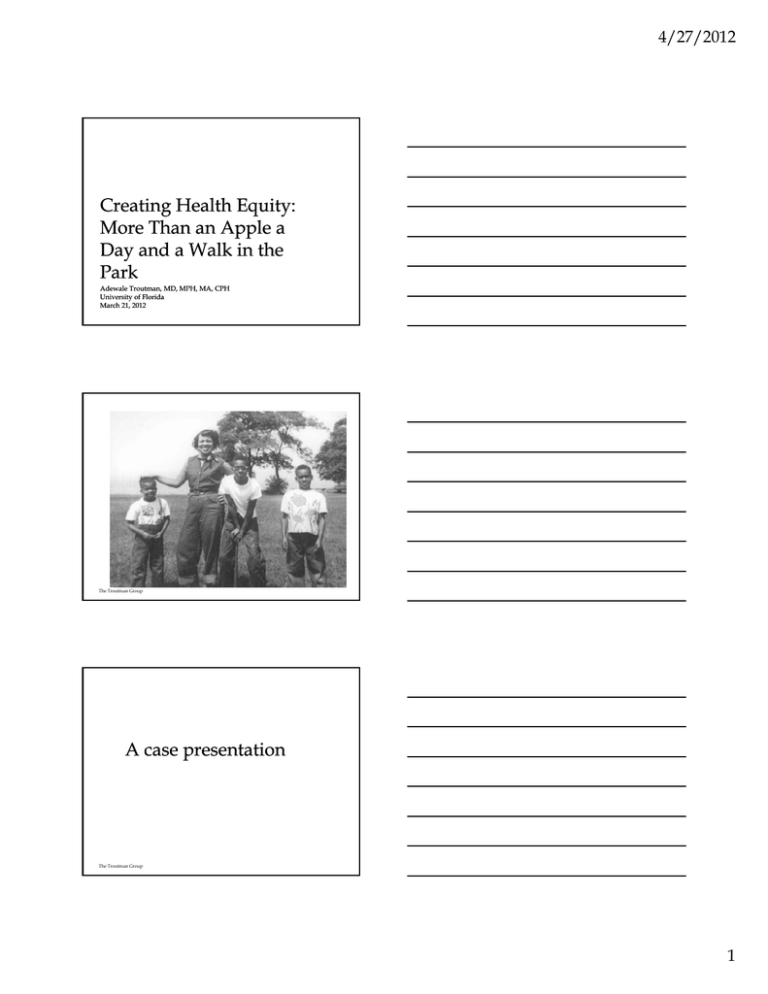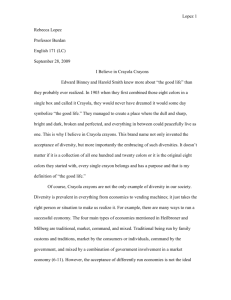Creating Health Equity: M Th
advertisement

4/27/2012 Creating Health Equity: More M Than Th an Apple A l a Day and a Walk in the Park Adewale Troutman, MD, MPH, MA, CPH University of Florida March 21, 2012 The Troutman Group A case presentation The Troutman Group 1 4/27/2012 The Troutman Group Vital Statistics: The Troutman Group What If We Had Eliminated Disparities in the Last Century? Fewer Black Deaths… In 2000 85,000 overall 24,000 from heart disease 7,000 from HIV / AIDS 4,700 infant deaths 22,000 from diabetes 2000 fewer Black women from breast cancer More Health Insurance Coverage… 2.5 million Blacks, including 620,000 children 2 4/27/2012 In a recent study, individual behaviors such as cigarette smoking, alcohol use and physical activity explained l i d less l than h 20% off the h difference in death rates among income groups How you frame an issue The questions you ask Determines your analysis of the issue Determines how h you prioritize it Determines your policy choices Determines resource allocation Can determine your allies and your enemies Can define when an issue has been resolved The Troutman Group Evolution of a concept 3 4/27/2012 Health Equity “Health equity is the realization by ALL people of the highest attainable level of health. Achieving health equity requires valuing all individuals and populations equally equally, and entails focused and ongoing societal efforts to address avoidable inequalities by assuring the conditions for optimal health for all groups, particularly for those who have experienced historical or contemporary injustices or socioeconomic disadvantage.” The Troutman Group Health Inequities Systemic, avoidable, unfair and unjust differences in health status and mortality rates and in the distribution of disease and illness across population groups. groups They are sustained over time and generations and beyond the control of individuals The Troutman Group Justice The quality of fairness The principle of moral rightness; equity Conformity to morall rightness in action or attitude C f h d 4 4/27/2012 Social Justice The application of principles of justice to the broadest definition of society Implies p Equity Equal access to societal power, goods and services Universal respect for human and civil rights Rights: Claims or entitlements that are recognized by legal or moral principles Human Rights (Summary) Universal Universal,, the birthright of every human being; Aimed at safeguarding the inherent dignity and equal worth of everyone; Inalienable (they cannot be waived or taken away); Interdependent and interrelated (every human right is closely related to and often dependent upon the realization of other human rights); Articulated as entitlements of individuals ((and and groups) groups) generating obligations of action and omission omission,, particularly on States; Internationally guaranteed and legally protected 5 4/27/2012 Universal Declaration of Human Rights December 10, 1948 Article 1: “All human beings are born free and equal in dignity and rights.” Article 24: “Everyone has the right to a standard of living adequate for the health and well being of him self and is family including food, clothing, housing and medical care.” The Right to Health Preamble to the constitution of the WHO states “ The enjoyment of the highest standard of health is one of the fundamental rights of every human being without distinction of race, religion, political belief, economic or social condition The Troutman Group The right to health or the right to health care is recognized in at least 115 constitutions. 6 4/27/2012 Constitution of Ecuador (1998) Chapter IV: Economic, Social and Cultural Rights, art. 42: “The State guarantees the right to health, its promotion and protection, through the development of food security, the provision of drinking water and basic sanitation, the promotion of a healthy family, work and community environment, and the possibility of permanent and uninterrupted access to health services, in conformity with the principles of equity, universality, solidarity, quality and efficiency.” Health equity as a development outcome The development of society can be judged by: populations’’ health • the quality of its populations • the fairness in distribution of health, and • the degree of protection provided from disadvantage due to illill-health Marmot 2006 Harveian Oration The Troutman Group A New Direction; Social Determinants of Health The Troutman Group 7 4/27/2012 Looking upstream, finding the causes of he causes. “The web of causation” The Troutman Group Social Determinants Socioeconomic Status Occupation Education Income Income gaps Racism & discrimination Housing Political power WHO • Early Life • Social Exclusion • Work k • Unemployment • Social Support • Addiction • Food • Transport • The Social Gradient • Stress The Troutman Group Healthy People 2020 Overarching Goals Attain high quality, longer lives free of preventable, disability, injury and premature death Q , ACHIEVE HEALTH EQUITY,ELIMINATE HEALTH DISPARITIES AND IMPROVE THE HEALTH OF ALL GROUPS Create social and physical environments that promote good health for all Promote quality of life, healthy development and healthy behaviors across all life stages 8 4/27/2012 Healthy People 2020 – Phase II New Topic Areas Adolescent Health Quality of Life Early and Middle Social Determinants of Health Childhood Blood Disorders and Blood Safety Older Adults Genomics Healthcare Associated Infections Global Health The Social Gradient Stress Continuing existence of anxiety, insecurity, low self esteem and social isolation Lack of control over home and work life Profound effect on health Cumulative “When the bough breaks” The Troutman Group 9 4/27/2012 Place Matters and the p power of GIS Life Expectancy: Louisville Metro 80 79 77 78 75 76 73 74 72 69 70 68 66 64 District 16 Nat. Ave. District 24 District 21 District 5 29 Environmental Stre ssors Number of Premature Deaths African-American Males All C ancers 1991 - 1995 10 4/27/2012 11 4/27/2012 And with the food environment 12 4/27/2012 The role of residential segregation; “The metropolitan areas with the highest segregation levels have the most unequal geographies of opportunity” Delores Acevedo Acevedo--Garcia et al Opportunity Neighborhoods Sustainable employment High performing schools Access to high h h quality l h healthcare lh Adequate transportation High quality childcare Neighborhood safety Institutions that facilitate civic engagement Housing The Troutman Group 13 4/27/2012 Housing and Health Lead Indoor air quality Unsafe environments Obesity Asthma Stress The Troutman Group The Troutman Group The Troutman Group 14 4/27/2012 Place and Environment Education The Troutman Group In El Salvador, if mothers had no education their babies have 100 chances in 1000 of dying in their first year of life; if mothers have at least secondary education the infant death rate is a quarter of that (World Bank 2006) The Troutman Group 15 4/27/2012 Food Justice Individual choice vs. structure and systems Food access, transportation and quality Decreased d access to healthy h l h foods, f d increased d access to unhealthy foods ( food deserts ) Economic development and community health The Troutman Group Healthy Food Access • In MS, NC, MD, MN neighborhoods: 3x fewer places to consume alcoholic beverages in the wealthiest neighborhoods 4x more supermarkets in white neighborhoods Unequal access a variety of healthy food choices available to non-minority and wealthy communities Morland K et al. Neighborhood characteristics associated with the location of food stores and food service places. Am J Prev Med 2002;22:23-29. Strategy 3: Expand access to and distribution of healthy food. The Troutman Group 16 4/27/2012 The importance of leadership Increased Neighborhood Access The Troutman Group 17 4/27/2012 Racism The Troutman Group What is racism? A system of structuring opportunity and assigning value based on the social interpretation of how one looks (“race”) Unfairly disadvantages some individuals and communities Unfairly advantages other individuals and communities Saps the strength of the whole society through the waste of human resources The Troutman Group Source: Jones CP, Phylon 2003 Joy – a feeling That can last a moment Even a day or a week Hurt – also a feeling that Can last generations… 18 4/27/2012 Rivera Center for Health Equity (CHE) CHE works to eliminate social and economic barriers to good health, reshape the public health landscape, and serve as a catalyst for capacity building, policy change and evidenced-based initiatives. The role of residential segregation; “The metropolitan areas with the highest segregation levels have the most unequal geographies of opportunity” opportunity” Delores Acevedo Acevedo--Garcia et al The Troutman Group 19 4/27/2012 Opportunity Neighborhoods Sustainable employment High performing schools Access to high h h quality l h healthcare lh Adequate transportation High quality childcare Neighborhood safety Institutions that facilitate civic engagement The Troutman Group Health Policy y Is Social Policy The Troutman Group Some New Tools The Troutman Group 20 4/27/2012 Photo Voice Youth empowerment through engagement Community health and barriers Youth h as creators, producers, d interpreters Raise awareness about the policy process Presentation to policy makers ( Mayor Metro Council, Board of Health, Business Community The Troutman Group If my community were healthy it would look like, no people littering, people riding bikes, no people dealing drugs, kids playing at the park, no gunshots, parents and kids walking their dogs, no people smoking, parents taking their baby’s in a stroller to the park to walk them around The Troutman Group the park. Denzel: age 10 My neighborhood has many train tracks and a really big factory that does something, thi I don’t know what. There is a church, a community center but there is no store close to where I live. The Troutman Groupage 10 D’coreyan: 21 4/27/2012 Every day I go to the community center on the side of it, they are selling drugs or showing off their guns and sometimes I am scared to walk pass because I think they will shoot me. Michael: age 10 The Troutman Group Health in All Policies addresses the effects on health across all policies such as agriculture, education, the environment, fiscal policies, housing, and transport. transport. It seeks to improve health and at the same time contribute to the well well-being and the wealth of the nations through structures, mechanisms and actions planned and managed mainly by sectors other than health. Thus HiAP is not confined to the health sector and to the public health community, but is a complementary strategy with a high potential towards improving a population population’’s health, with health determinants as the bridge between policies and health outcomes. The Troutman Group Health Impact Assessment The Troutman Group 22 4/27/2012 Health Impact Assessment (HIA) A combination of procedures, methods, and tools by which a policy, program, or project may be judged as to its potential effects on the health of a population, population and the distribution of those effects within the population (Gothenburg consensus statement, 1999) Social justice is a matter of life and death. It affects the way people live, their consequent chance of illness, and their risk of premature death… The Troutman Group www.who.int/social_determinants CSDH three overarching recommendations: 1. Improve daily living conditions 2. Tackle the unequal distribution of power, money and resources d 3. Measure and understand the problem and assess the impact of action The Troutman Group 23 4/27/2012 Remember Health is more than health care Health l h Inequities are neither h naturall nor inevitable bl The choices we make are shaped by the choices we have Racism imposes and additional health burden What to do Reframe Reframe--See the problem differently Social Determinants research Multidisciplinary program development and implementation & curriculum change Invitation for self evaluation Engaging nontraditional partners Think globally act locally Get involved 24 4/27/2012 Building a Social Movement; A Common Vision of Hope The Power of One One” “The The Troutman Group The Troutman Group The Troutman Group 25 4/27/2012 To laugh is to risk appearing a fool. To weep is to risk appearing sentimental. To reach out for another is to risk involvement. To expose your feelings is to risk exposing your true self. T place To l your ideas, id your d dreams b before f th the crowd is to risk there loss. To love is to risk not being loved in returned. To live is to risk dying. To hope is to risk despair. To try is to risk failure. . But risks must be taken because the greatest hazard in life is to risk nothing. The person who risks nothing, does nothing, has nothing, and is nothing. He id suffering ff i and d sorrow, b may avoid butt h he can't simply learn, feel, change, grow, love or live. Chained by his certitude, he is a slave, he has forfeited his freedom. ONLY A PERSON WHO RISKS IS FREE The Troutman Group 26 4/27/2012 Adewale Troutman, MD, MPH, MA, CPH The Troutman Group www.denzibell@aol.com College of Public Health University of South Florida 311 Fletcher Ave, MDC 100 atroutm1@health.usf.edu 813--974 813 974--9302 What Do I Do? Recommit to Health Equity and the belief that IM and community health is a social justice issue Expand your organizational and personal contacts t non ttraditional to diti l partners t ( unions, i civil i il rights i ht groups, jobs for justice advocates, the faith community in a new way, urban planners and zoning experts, economic development agencies, youth HIP HOP groups etc.) Strengthen or begin a relationship with local, state and congressional delegations What? See the problems differently ( Community Empowerment vs Medical model ) This is a women’s health, child health and men’s health issue 27 4/27/2012 Healthy People 2020: The Process Revealed Office of Disease Prevention and Health Promotion US Department of Health and Human Services Adewale Troutman, M.D., M.A., M.P.H. September 29, 2008 Advisory Committee Workgroups • Five subcommittees to allow in in--depth discussion • Members were both internal and external (subject experts) Subcommittee on Health Equity and Disparities Subcommittee on Priorities Subcommittee on Environment and Determinants Subcommittee on Life Stages and Developmental stages Subcommittee on User Questions and Needs • Two AdAd-hoc groups to address special topics Health IT Graphic model for Healthy People 2020 83 Black women are at increased risk for adverse birth outcomes Ectopic pregnancy p abortion Spontaneous Cesarean delivery Preterm birth Low birth weight Birth defects Infant death Maternal death from pregnancy-related complications Reveiwed by: S. Gennaro, Am J Obstet Gyneco 192, S3–10, 2005 28 4/27/2012 “Focusing on prenatal care in our public health policy prescription for infant mortality disparities ignores the socioeconomic context in which women live, medicalizes a problem that is socially and historically complex, and thus contributes to the illusion that there is a ‘medical policy bullet’ that can provide a comprehensive and efficacious solution” Frisch & Lantz 1999 Disparities in health, education, employment, and wealth, along with persistent residential segregation, are vestiges of a long history of oppression and denial of fundamental human rights. The legacy of racial injustice shadows this nation ti and d Af African i American A i Communities C iti in i the form of persistent infant mortality disparities. True healing must emerge through acknowledgement, reconciliation, and amelioration of the inequalities that continue to disproportionately burden African Americans and other people of color Christopher, 2005 Accomplishments of the Healthy Start Program, 2001 2001--2005 Zero infant mortality to Healthy Start participants over 4 years Significant reduction in low birth birth--weight bi h births Increase in the women receiving prenatal care during the first trimester Increase in the women receiving preventive care services after delivery 29 4/27/2012 Secretary’s Advisory Committee on Infant Mortality 2011 Workgroups Recommendations Living and working conditions include social, natural and physical environments; racial segregation, employment status and occupational factors and available social services and health care services. 30 4/27/2012 31




